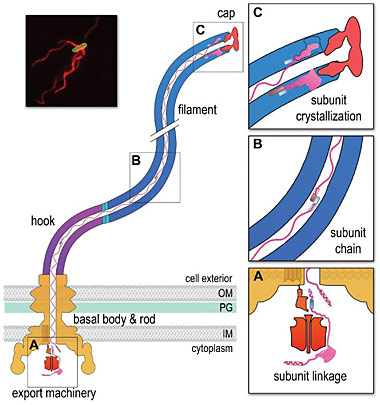The Dr Fraser is currently not accepting enquiries from prospective students.
Biography
Gillian Fraser joined the Department of Pathology as a postgraduate student in Microbiology. On completing her studies and after a short post-doc, she was awarded a Wellcome Trust International Prize Travelling Research Fellowship to work on bacterial flagella biogenesis at Yale University. She returned to the Department to complete her fellowship and take up a University Lectureship in Cellular and Molecular Microbiology.
At Queens' College, Gillian is Director of Studies (Pathology) and a Fellow in the Natural Sciences.
Research
Bacterial motility & flagella biogenesis Pathogenic bacteria are often motile and their ability to swim through liquids and swarm over surfaces facilitates pathogen-host interactions and colonization of nutrient–rich environments. Many bacteria build complex rotary nanomotors, called flagella, which drive swimming and swarming motility. A remarkable feature of flagella is that they are essentially self-assembling. Thousands of flagellar structural subunits are exported across the cell membrane by dedicated type III export machinery located at the base of each flagellum. Subunits then transit through a narrow channel at the core of the nascent flagellum to reach the assembly site at the tip of the structure, up to 20 μm away from the cell surface. Our work aims to uncover the molecular mechanisms underpinning flagellum assembly, focusing on the interactions between flagellar structural proteins and components of the membrane export machinery. Funded by a BBSRC project grant.
A chain mechanism for bacterial flagellum growth (see Nature 504:287-290). Flagella on the surface of the bacterial cell (inset top right, Salmonella cell membrane stained green and flagella stained red) comprise three contiguous substructures - the basal body, hook and filament - that are assembled sequentially. A central channel runs through these substructures to the flagellum tip.The basal body houses the flagellar export machinery (A) and the rod, which extends from the inner membrane (IM) and crosses the periplasm, peptidoglycan (PG) cell wall and outer membrane (OM). The cell surface hook is a flexible universal joint that connects the external flagellum filament to the basal body.

(A) Subunits of the rod, hook and filament link head-to-tail at the cytoplasmic membrane export machinery. Subunits are first unfolded by the export ATPase complex (red). Rod and hook subunits then dock at the FlhB export gate (orange). The N-terminal helix of the docked subunit is then captured by the free C-terminal helix of an exiting subunit in the flagellum channel. (B) Sequential subunits are linked head-to-tail in a chain by juxtaposed terminal helices forming parallel coiled-coils. The resulting chain of unfolded subunits is connected through the flagellum central channel to the distal tip of the growing structure. (C) The subunits in the chain transit from the gate to the tip. Subunits fold and incorporate into the flagellum tip beneath cap foldases. Subunit folding and/or crystallization not only provides a strong anchor at the flagellum tip, it also shortens the subunit chain in the channel thus exerting a pulling force on the next subunit at the export gate, pulling it from the gate. The pulling force then drops rapidly as the new unfolded subunit enters the channel. This process repeats for each subunit captured into the chain.
Bacterial nucleoid structure & gene expression The bacterial nucleoid is a large dynamic structure containing DNA, RNA and proteins. To fit into the cell the nucleoid must be compacted extensively, and must fold in ways that allow genetic information to be replicated and transcribed. This is especially important in bacteria as their survival depends on their ability to adapt rapidly to the external environment by modulating gene expression and growth rate. We aim to understand how the nucleoid folds and how this folding influences transcription. Nucleoid folding is orchestrated, in part, by specialized DNA-binding proteins called nucleoid associated proteins (NAPs). We have mapped the genomic binding sites of several NAPs - including Fis, HNS, IHF and HU - in the model bacterium E. coli K12. We have also determined the effects of NAP binding on both gene expression and genome-wide binding of RNA polymerase. We are now building on this work to study how NAPs influence long-range DNA interactions and the 3D structure of the nucleoid. In collaboration with Pietro Cicuta, Department of Physics.
Publications
Bryant OJ, Dhillon P, Hughes C, Fraser GM (2022) Recognition of discrete export signals in early flagellar subunits during bacterial Type III secretion eLife 11, e66264
Bryant OJ, Fraser GM (2021) Regulation of bacterial Type III Secretion System export gate opening by substrates and the FliJ stalk of the flagellar ATPase. The FEBS Journal doi:10.1111/febs.16294
Bryant OJ, Chung BYW, Fraser GM (2021) Chaperone‐mediated coupling of subunit availability to activation of flagellar Type III secretion Molecular Microbiology 116 (2), 538-549
Evans LDB, Hughes C and Fraser GM. (2014) Building a flagellum outside the bacterial cell. Trends in Microbiology 22: 566-572
Evans LDB, Poulter S, Terentjev EM, Hughes C and Fraser GM. (2013) A chain mechanism for flagellum growth. Nature 504:287-290
Kahramanoglou C, Seshasayee ASN, Prieto A, Ibberson D, Schmidt S, Zimmerman J, Benes V, Fraser GM* and Luscombe NM* (2011) Direct and indirect effects of H-NS and Fis on global gene expression control in E. coli. Nucleic Acids Research 39:2073-91.
Green JCD, Kahramanoglou C, Rahman A, Pender A, Charbonnel N, and Fraser GM (2009) Recruitment of the earliest component of the bacterial flagellum to the old cell division pole by a membrane-associated flagellar signal recognition particle-family GTPase. Journal of Molecular Biology 391:679-90.
Evans LDB, Stafford GP, Ahmed S, Fraser GM, and Hughes C (2006) An escort mechanism for cycling of export chaperones during flagellum assembly. Proceedings of the National Academy of Sciences USA 103: 17474-17479


